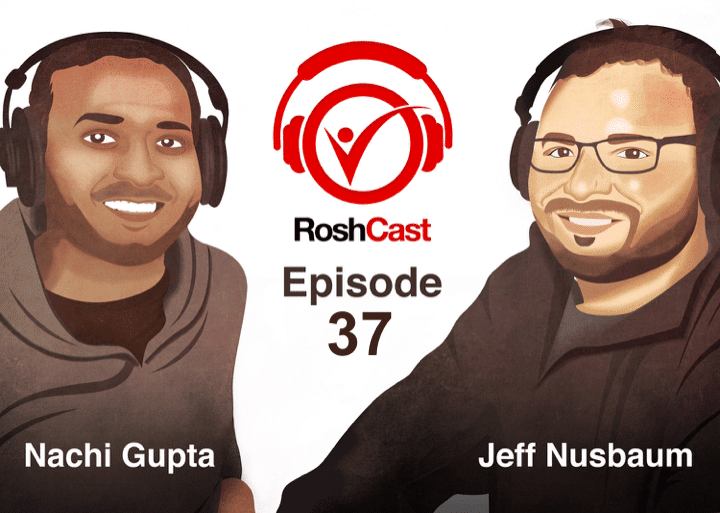Podcast Ep 37: Tibial Vein Clot, PR Interval & More

The most difficult thing is the decision to act, the rest is merely tenacity. The fears are paper tigers. You can do anything you decide to do. You can act to change and control your life; and the procedure, the process is its own reward.
-Amelia Earhart
Welcome back to Roshcast Episode 37! This week, we’re continuing our collaboration with the EM Clerkship podcast. We’ll cover 3 EKG related questions in addition to 3 randomly generated questions. Maybe we’ll even get to a trauma question…
As a reminder, listen closely for the trauma ring tone during this episode and the next episode. And e-mail us at roshcast@roshreview.com or tweet us at Roshcast the exact time of the ring tone to win a subscription. With the in-training exam right around the corner, this will certainly help get you ready for February 28th. Let’s get going with a rapid review from a recent post on the Rosh Review Blog.

- Supracondylar fracture is the most common type of pediatric elbow fracture. Typically caused by falling on an outstretched hand — or a FOOSH.
- In a posterolaterally displaced supracondylar humeral fracture, you should be concerned for the median nerve. This can be tested by asking the patient to make an “OK” sign and checking sensation at the volar tip of the index finger
- For a posteromedially displaced supracondylar fracture you should be concerned about the radial nerve. Have the patient try to make a “thumbs up” sign. And check sensation along the dorsal web space of the hand.
Now onto this week’s podcast
Question 1
A previously healthy patient who presents with leg pain is found to have a clot within the tibial vein. Which of the following treatments is most likely indicated?
A. Aspirin for 6 months
B. Heparin and warfarin
C. Repeat ultrasound in 2–5 days
D. Warfarin alone
Question 2
Which of the following is associated with a shortened PR interval?
A. Brugada syndrome
B. Mobitz 2° AV Block
C. Wellens syndrome
D. Wolff-Parkinson-White syndrome
Question 3
A 29-year-old man presents after a syncopal episode. His ECG reveals an epsilon wave, a small positive deflection buried in the end of the QRS complex. Which of the following tests will likely identify the cause of the patient’s syncope?
A. Cardiac catheterization
B. Cardiac MRI
C. Electrophysiology study
D. Stress testing
Question 4
A 12-year-old boy is brought to the ED after being struck in the chest by a baseball during a baseball game. He collapsed immediately upon impact and has been unresponsive since. Which of the following dysrhythmias is most commonly associated with this condition?
A. Asystole
B. Supraventricular tachycardia
C. Ventricular fibrillation
D. Ventricular tachycardia
Question 5
A 57-year-old man with hypertension presents complaining of a 6-hour history of a “floater” in the right eye. He states that he has had increasing difficulty reading as the cloudy area blocks his visual field. Additionally, he complains of decreased vision in his right eye. Which of the following represents the appropriate management?
A. Administer timolol drops and emergently consult ophthalmology
B. Emergent ophthalmology consultation
C. Prescribe topical antibiotics and refer to ophthalmology
D. Refer patient to ophthalmology for further assessment
Teaching Image
Question 6
A 27-year-old woman and her 25-year-old sister present with symptoms of facial flushing, headache, abdominal cramping, and diarrhea after eating in a seafood restaurant. They report that the fish they ate had a peppery taste. Which of the following is the most likely cause of their symptoms?
A. Anaphylaxis
B. Ciguatera
C. Scombroid
D. Staphalococcus aureus food poisoning

- Isolated thromboses of the calf veins can be managed by repeating an ultrasound in 2–5 days to determine the need for anticoagulation.
- Phlegmasia cerulean dolens is caused by extensive iliofemoral occlusion, which leads to vascular congestion and venous ischemia and a painful blue leg.
- Phlegmasia alba dolens is caused by a massive iliofemoral thrombosis and spasm and leads to a white leg.
- WPW is a congenital abnormality characterized by an abnormal accessory conduction pathway between the atria and the ventricle known as the bundle of kent. Look out for a delta wave, short PR, and widened QRS interval on EKG. The definitive treatment is ablation.
- Brugada syndrome is a hereditary condition characterized by a right bundle branch block-like pattern with ST elevation in leads V1 through V3.
- Wellens syndrome is caused by critical stenosis of the proximal LAD. On EKG you will likely see large inverted T waves or biphasic T waves in leads V2 and V3.
- Epsilon waves, which are small positive deflections buried in the terminal QRS complex, are characteristic of arrhythmogenic right ventricular cardiomyopathy. It is diagnosed by cardiac MRI.
- Arrhythmogenic right ventricular cardiomyopathy is treated with antiarrhythmics and an implantable cardiac defibrillator.
- Commotio cordis occurs when an object strikes the chest over the heart. It can cause sudden death. Commotio cordis is most common in children 5–15 years old, and ventricular fibrillation is the most common underlying rhythm.
- The commotio cordis risk window is the upstroke of the T wave in the cardiac conduction cycle.
- Posterior vitreous detachment can cause floaters, decreased vision, and cloudiness. Acute changes warrant emergent ophthalmology consultation.
- Scombroid poisoning presents with facial flushing, headache, abdominal cramping and diarrhea, palpitations, and rashes. Onset of symptoms can be anywhere from 10 minutes to 24 hours. Treatment is supportive with H1 and H2 blockers.
- Ciguatera toxicity is associated with muscle weakness, paresthesias, vomiting, diarrhea, and reversal of hot-cold sensation.
That wraps up Roshcast Episode 37. Before we officially sign off for this week, we wanted to solicit your help for an upcoming episode. Very soon, we are bringing Adam Rosh, who is the founder of Rosh Review, onto the podcast to discuss everything from study tactics to his favorite pre-test meal. We have a couple of our own questions lined up, but we want to know what questions you have. Send us any questions for Adam to jeff@roshreview.com and we’ll try to squeeze them all in. That’s it for this week. Don’t forget to follow us on Twitter @Roshcast and @RoshReview. And you can always email us at roshcast@roshreview.com with any feedback, corrections or suggestions. You can also help us pick questions by identifying ones you would like us to review. Write “RoshCast” in the submit feedback box as you go through the question bank. Lastly, if you have a minute, make sure to rate us and leave comments on iTunes to help spread the word about RoshCast. We’ll be back soon with more high-quality review.
Until next time,
Jeff and Nachi





Comments (0)